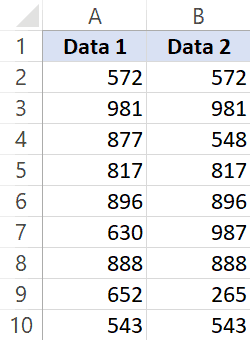

Another way to do this is to use the Custom format. Essentially, if the value is TRUE, you want to color the font the same as the background. In our first example, we could use Conditional Formatting to change the font to white if the value is TRUE, thereby making it “invisible” as long as the cell shading was empty or white. We can use an If statement to test the result of the VLookUp and return a blank if the VLookUp does not result in an #N/A. We really only need to see if it isn’t found.

The information that Excel found the value we were looking up isn’t really necessary. We locate all the names in column B in column A, but one.

In our example, the two lists are sorted differently. Like our FALSE result above, VLookUp returns #N/A, telling us the thing we’re looking up is “not available.” The “where” or Table Array field should be expressed as an Absolute Cell Reference ($A$1) or a named range so it doesn’t “travel” as we copy our formula down the list. And, we want Excel to tell us if it can’t find it, we tell it not to return something close to our value (range), but our value exactly. The which column is the same column we’re looking it up in, so 1. So, the “what” is the value we want to look up. In our case, we’re only comparing two columns, one in each of two separate lists.
#Compare two columns in excel for match how to
In the sample workbook, with any value in column C selected, click on the Conditional Formatting button on the Home tab and choose Manage Rules to see how to highlight a whole row based on the value in one column. To see just your FALSE values, you can filter or apply Conditional Formatting to highlight the false ones. Excel says “No it’s not!” by returning the value FALSE. So, these appear as FALSE in the third column where the formula attempts to state that the value in column B is equal to the value in column C. In our example, we see that Ali Mazzurah’s name has a missing h at the end, and Kathleen Kelly’s name appears with her middle initial V. If they are, Excel returns the value TRUE. If they are not equal, Excel returns the value FALSE. If you have two lists that should be identical, but you suspect they might not be, you can put in a simple formula that sets one cell equal to another. Note: All values will appear highlighted on the This Equals That Worksheet, initially. By Melissa Esquibel Categories: Conditional Formatting, Excel®, VLOOKUP Tags: Comparing Columns in Excelĭid you ever squint at two columns of data and examine them row by row to compare the values? Excel can do all that hard work for you in three different ways.ĭownload CompareColumnsinExcel.xlsx to follow along.


 0 kommentar(er)
0 kommentar(er)
